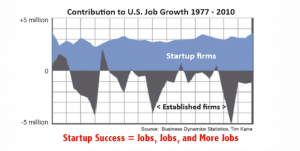According to recent research by Shikhar Ghosh, a senior lecturer at Harvard Business School, based on data from more than 2,000 companies, 75% of venture-backed startups fail.
Of course, there are different ways to define failure, but losing all the money you’ve put in – or losing your dream – certainly qualifies. Some might use shorter-term benchmarks, like achieving sales and revenue targets within a given timeframe, in which case an even higher percentage of funded startups would probably wind up sporting a big red F.
This is important, not just for startup teams and not just for the investors, but for the U.S. economy as well. This chart showing 33 years of net annual job growth tells you why: Startup ventures create jobs. Big companies don’t.
So the really big questions are, why do so many startups fail – and what can be done about it?
Studies have identified various issues that contribute to the blow-up of startup teams, including competitive factors, market factors, technology churn and such, but the #1 – by a long shot – indicator of pending demise can be summarized with just one diagnosis: Connectile Dysfunction.
Connectile Dysfunction (or CD, as we team-oriented entrepreneurs call it) causes the heartbreak of startup failure, which leads to chronically depressed economies.
Sound dangerous? Contagious? Fatal? It can be. But thankfully, CD is diagnosable and treatable. There’s even a way to immunize against it.
CD happens when the way in which people connect with each other lacks sufficient respect, trust, and faith in the team vision. This can happen with people on the team, as well as with customers, investors, vendors, and the larger social community.
CD creates disappointment, misunderstandings, and stress. This exacerbates the problem, and also blocks quick resolution. The side effects can have long lasting, demoralizing effects on every team member.
So, let’s say you believe your team has some level of CD and just isn’t up for the challenge. (Yes, there is a spectrum of severity for this disorder.) What to do? Start by asking these not-so-simple questions:
- Do you have the right people on the team? That is,
- Do they actually want to do that work?
- Do they do the work at the quality level the job demands?
- Are they relatively free of ways of working together that you don’t want to encourage in your culture?
- Are they doing their work in a way that keeps their connections with people ‘clean and clear’? Do they have the right kind of supports and do they have the appropriate level of autonomy?
- Have you noticed any particularly odious qualities to the way they interact with others?
Keep in mind that 75% of VCs and private investors thought they knew the answers to these crucial teaming problems. But they didn’t, and it cost them plenty. Now they are probably a little gun-shy and less likely to pull the trigger on the next startup opportunity, which won’t do anything for the economy.
A variety of new approaches, from neurological studies to the mining of ‘big data,’ are being applied to the search for new ways to identify, assemble, and lead the right teams for the right mission. One such technology elicits ‘teaming’ behavior, and takes a direct measure of the different ways that individuals seek to contribute to organizational needs, thereby producing the analytics of team chemistry, and new ways to structure and manage teams for optimal performance.
Now picture an island holiday, a glass of fine wine at sunset beneath swaying palms, with the promise of great things to come hanging heavy in the air: profit-sharing, stock grants, market domination, culminating in a climactic liquidity event.
That’s reality for some entrepreneurs – the ones who built great teams. So before you invest your dreams, time, energy, and/or money, take personal responsibility for preventing CD, and look for help in the areas of team analysis, teaming analytics, and team development.
You could start by tweeting me, @DrJanice. Stat.




